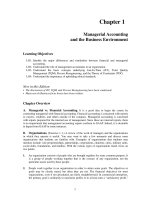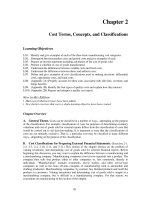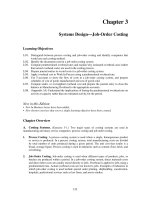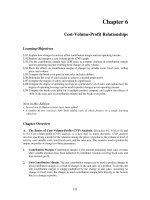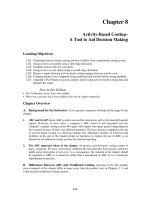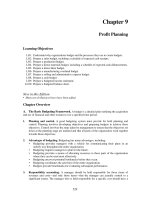Overview managerial accounting chapter 010
Bạn đang xem bản rút gọn của tài liệu. Xem và tải ngay bản đầy đủ của tài liệu tại đây (3.96 MB, 92 trang )
Chapter 10
Standard Costs and the Balanced Scorecard
Learning Objectives
LO1. Explain how direct materials standards and direct labor standards are set.
LO2. Compute the direct materials price and quantity variances and explain their
significance.
LO3. Compute the direct labor rate and efficiency variances and explain their significance.
LO4. Compute the variable manufacturing overhead spending and efficiency variances.
LO5. Understand how a balanced scorecard fits together and how it supports a company’s
strategy.
LO6. Compute the delivery cycle time, the throughput time, and the manufacturing cycle
efficiency (MCE).
LO7. (Appendix 10A) Prepare journal entries to record standard costs and variances.
New in this Edition
• A number of new In Business boxes have been written for this edition.
• Several new exercises have been added, each of which focuses on a single learning objective.
• New problems covering the Balanced Scorecard have been added..
Lecture Notes
A. Standard Costs—Management by Exception. A standard is a benchmark or “norm”
for measuring performance. In managerial accounting, standards relate to the prices and
quantities of inputs used in making goods or providing services.
1.
Quantity standards. A quantity standard specifies how much of an input, such as labor
time or raw materials, should be used to make a unit of product or to provide a unit of
service. To measure performance, the actual quantity of an input that is used is compared to
the standard quantity allowed for the actual output of the period.
2.
Price standards. A price standard specifies how much each unit of input should cost.
Actual costs of inputs are compared to these standards.
B. Setting Standard Costs. (Exercises 10-1, 10-8.) Standards should be set so that they
encourage efficient operations.
1.
Ideal versus practical standard. Standards tend to fall into one of two categories—either
ideal or practical.
• Ideal standards allow for no machine breakdowns or work interruptions, and require
that workers operate at peak efficiency 100% of the time. Since ideal standards are
604
•
rarely met, most managers believe they tend to discourage even the most diligent
workers. On the other hand, some critics maintain that only ideal standards are
appropriate in an era of continual improvement. Any other standard may breed
complacency.
Practical standards are “tight, but attainable.” They allow for normal machine
downtime and employee rest periods and can be attained through reasonable, but highly
efficient, efforts by the average worker.
2.
Setting direct materials standards. Separate standards are prepared for the price and
quantity of each type of material input.
• The standard price per unit for a direct material should reflect the final, delivered
cost of the material, net of any discounts taken. The standard price is for a particular
grade of material, purchased in a particular lot size, and delivered by a particular type
of carrier.
• The standard quantity of a direct material per unit of output in a traditional
standard cost system reflects the amount of material going into each unit of finished
product, as well as an allowance for unavoidable waste, spoilage, and other normal
inefficiencies. However, it is worth pointing out that some experts argue that “normal”
inefficiency can no longer be tolerated and that companies that build waste into their
operations will ultimately face serious problems competing with companies that don’t.
3.
Setting direct labor standards.
• The standard rate per hour for direct labor should include not only wages, but also
fringe benefits and other labor-related costs. Ordinarily, the standard rate is an average
that assumes a specific mix of higher and lower paid workers.
• The standard direct labor-hours per unit of output is the direct labor time allowed
to complete a unit of product. In traditional standard cost systems this standard time
includes allowances for coffee breaks, personal needs of employees, clean-up, and
machine downtime.
4.
Setting variable manufacturing overhead standards. Standards for variable
manufacturing overhead are usually expressed in terms of direct labor-hours or machinehours. The rate represents the variable portion of the predetermined overhead rate that is
discussed in Chapter 3. The standard hours for variable overhead represent the standard
hours for whatever base is used to apply overhead cost to products or services. If direct
labor-hours is the basis for applying overhead to products, then the quantity standard for
variable manufacturing overhead will be the quantity standard for direct labor.
5.
Standard cost card. A standard cost card is a summary of the standard costs of inputs
required to complete one unit of product. For each input, the standard cost card lists the
standard price of the input, the standard quantity of the input allowed per unit of output,
and the standard cost of the input per unit of output. The latter is equal to the standard price
per unit of input multiplied by the standard quantity of the input allowed for each unit of
product.
6.
Standards and budgets. One distinction between a standard and a budget is that a standard
is a unit amount, whereas a budget is a total amount. In effect, a standard can be viewed as
the budgeted cost for one unit.
605
C. A General Model for Variance Analysis. A variance is the difference between
standard prices and actual prices or between standard quantities and actual quantities. A general
model that describes the variable cost variances is found in Exhibit 10-3.
1.
Price variance. A price variance is the difference between the how much should have been
paid to acquire an input and how much was actually paid.
2.
Quantity variance. A quantity variance is the difference between how much of an input
should have been used to produce the actual output of the period and how much was
actually used, multiplied by the standard price of the input.
3.
Alternative methods. As an alternative to the general model, variances can be computed
using formulas. The formulas for the price variance are:
Price (rate) variance = (AQ × AP) – (AQ × SP)
or
Price (rate) variance = AQ (AP – SP)
The formulas for the quantity variance are:
Quantity (efficiency) variance = (AQ × SP) – (SQ × SP)
or
Quantity (efficiency) variance = SP (AQ – SQ)
Where:
AQ = Actual quantity of inputs purchased (or used)
AP = Actual price per unit of inputs purchased
SP = Standard price per unit of input
SQ = Standard input allowed for the actual output. This equals the standard input per
unit of output multiplied by the actual output of the period.
D. Computation and Interpretation of Standard Cost Variances. Since direct
material, direct labor, and variable overhead are all variable manufacturing costs, the process of
computing price and quantity variances for each of these cost categories is the same. The general
model, or the formulas, can be used in each case to compute the variances. The only
complication is deciding in each case whether the actual quantity of inputs refers to the actual
quantity purchased or the actual quantity used.
1.
Direct material variances. (Exercises 10-2, 10-9, 10-12, 10-13, 10-15.)
a. The materials price variance is the difference between what is paid for a given quantity
of materials and what should have been paid according to the standard. Most
companies compute the material price variance when materials are purchased rather
than when the materials are placed into production. Generally speaking, the purchasing
manager has control over the price to be paid for goods and is therefore responsible for
any price variance. However, some other individual may be responsible in some
instances. For example, the production manager might be responsible if an unfavorable
price variance occurs as the result of rush orders for material due to poor production
scheduling.
For purposes of control, it is best to recognize a materials price variance immediately
rather than wait until the materials are withdrawn for use in production. Also, if the
606
material price variance is recognized when the materials are placed into production,
their actual costs must be tracked after they are purchased. If the variance is recognized
when the materials are purchased, materials inventories can be carried at standard
cost—which enormously simplifies the bookkeeping.
b. The materials quantity variance is the difference between the quantity of materials used
in production and the quantity that should have been used according to the standard—
all multiplied by the standard price per unit of input. Ordinarily, the materials quantity
variance is the responsibility of the production department. However, other individuals
may in some instances be responsible. For example, the purchasing department would
be responsible for an unfavorable material quantity variance that occurs because of the
purchase of inferior quality materials.
2.
Direct labor variances. (Exercises 10-3, 10-9, 10-10, 10-11, 10-12, 10-15.)
a. The labor rate variance measures any deviation from standard in the average hourly
rate paid to direct labor workers. Students often wonder how there can be a labor rate
variance since companies generally know each employee’s wage rate in advance. A
labor rate variance can arise for a number of reasons. The mix of workers, and hence of
lower and higher wage rates, can be different from what was planned due to absences,
changes in the composition of the work force, and a variety of other circumstances.
Additionally, overtime can give rise to a labor rate variance.
b. The quantity variance for direct labor is called the labor efficiency variance.
Traditionally, this has been the most closely monitored variance by management. When
the direct labor workforce is adjusted to changes in workloads, the main causes of the
labor efficiency variance include poorly trained workers, poorly motivated workers,
poor quality materials which require more labor time and processing, faulty equipment
which causes breakdowns and work interruptions, and poor supervision. However,
many companies do not adjust the workforce to the workload in the short-term. In such
companies, the major cause of a labor efficiency variance is likely to be fluctuations in
demand for the company’s products rather than the efficiency with which workers do
their jobs. If the workforce is basically fixed, a reduction in output will result in less
favorable labor efficiency variances. Likewise, an increase in output when the
workforce is basically fixed will result in more favorable labor efficiency variances.
When demand is down or when a workstation is not a bottleneck, excessive emphasis
on labor efficiency variances can create tremendous pressure to build inventories. Take
the case of a workstation that is not a bottleneck. If the labor force is basically fixed
and the standards are tight, the workstation can only attain a favorable labor efficiency
variance by producing at capacity. However, if the workstation is not the bottleneck
and it is operating at capacity, it will produce more output than the bottleneck can
process. That will result in work in process inventory that cannot be completed. As the
JIT movement attests, work in process inventory is the enemy of efficient operations. It
leads to long and erratic manufacturing cycle times, high defect rates, obsolescence,
and high overhead due to expediting and the problems of coordinating production
schedules amongst the general chaos on the factory floor. A very strong argument can
be made that the labor efficiency variance should be unfavorable in workstations that
are not bottlenecks when the work force is fixed.
607
3.
Variable overhead variances. (Exercises 10-4, 10-11.) These variances will be discussed
in greater depth in the next chapter. You may want to defer all discussion of the
interpretations of these variances.
a. The variable overhead spending variance is computed as follows when the variable
overhead rate is expressed in terms of direct labor-hours:
Variable overhead spending variance =
Actual overhead cost – Actual direct labor-hours × Variable overhead rate
The variable overhead spending variance compares actual spending on variable
overhead to the amount of spending that would be expected, given the actual direct
labor-hours for the period. The critical assumption inherent in this calculation is that
variable overhead spending should be proportional to the actual direct labor-hours. The
usefulness of this variance depends on the validity of this assumption. If in fact the
optimal level of variable overhead spending is not proportional to actual direct laborhours, then this variance has little meaning.
b. The variable overhead efficiency variance is computed as follows when the variable
overhead rate is expressed in terms of direct labor-hours:
Variable overhead efficiency variance =
(Actual direct labor-hours – Standard direct labor-hours allowed) × Variable
overhead rate
Note the similarity between the direct labor efficiency variance and the variable
overhead efficiency variance. In both cases, the actual direct labor-hours are compared
to the standard direct labor-hours allowed for the actual output. The only difference
between the variances is the standard rate that is applied to difference between the
actual and standard hours. In the case of the direct labor efficiency variance, the rate is
the standard labor rate. In the case of the variable overhead efficiency variance, the rate
is the standard (predetermined) variable overhead rate per direct labor-hour. Therefore,
these two variances really measure the same thing. Those who criticize the labor
efficiency variance as irrelevant or counter-productive would likewise criticize the
variable overhead efficiency variance.
E. Variance Analysis and Management by Exception. Management by exception
means that management’s attention should be directed towards areas where plans are not being
met. Standard cost variances signal performance different from what was expected. Since not all
variances require management attention, some method of identifying those variances that do
require attention is required. Statistical analysis can be useful in this task and the basics of this
approach are sketched in the text.
F.
General Ledger Entries to Record Variances (Appendix 10A). (Exercises 10-7,
10-15.) The appendix covers the journal entries to record standard costs in inventories and to
record the standard cost variances. Formal entry of variances in the accounting records gives
variances greater emphasis and simplifies the bookkeeping process. It is important to note that
unfavorable variances are debit entries and favorable variances are credit entries.
608
G. Potential Problems with Using Standard Costs. Some of the potential disadvantages
of standard costs have been mentioned above. A more complete list follows:
1.
Standard cost variance reports are usually prepared on a monthly basis and are released
long after the end of the month. As a consequence, the information in the reports may be so
stale that it is almost useless. It is better to have timely, frequent reports that are
approximately correct than to have untimely, infrequent reports that are very precise. Some
companies are now reporting variances and other key operating data daily or even more
frequently.
2.
Management by exception, by its nature, tends to focus on the negative. Moreover, if
variances are used as a club, subordinates may be tempted to cover up unfavorable
variances or take actions that are not in the best interests of the company to make sure the
variances are favorable. For example, workers may put on a crash effort to increase output
at the end of the month to avoid an unfavorable labor efficiency variance. During such
crash efforts, quality may not be a major concern. It is claimed that in the old Soviet Union,
workers used hammers instead of screwdrivers at the end of the month to meet production
quotas.
3.
Labor quantity standards and labor efficiency variances make two important assumptions.
First, they assume that the production process is labor-paced; if labor works faster, output
will go up. However, output in many companies is no longer determined by how fast labor
works; rather, it is determined by the processing speed of machines. Second, these
computations assume that labor is a variable cost. However, as discussed in earlier
chapters, in many companies direct labor may be more of a fixed cost than a variable cost.
And if labor is a fixed cost, then an undue emphasis on labor efficiency variances creates
pressure to build excess work-in-process and finished goods inventories as discussed
above. If every workstation is being evaluated based on its labor efficiency variance, then
every workstation will attempt to produce at capacity. But if the workstations in front of the
bottleneck produce at capacity, the inevitable result will be a build up of work in process
inventories in front of the bottleneck. This reasoning applies to any two successive
workstations with differing capacities. If the first workstation has greater capacity that the
second work station and attempts to produce to its capacity, the result will be everincreasing piles of work in process inventory in front of the second workstation.
4.
In some cases, a “favorable” variance can be worse than an “unfavorable” variance. For
example, vaccines have standard doses. A favorable quantity variance means that less
vaccine was used than the standard specifies. The result may be an ineffective inoculation.
5.
There may be a tendency with standard cost reporting systems to emphasize meeting the
standards to the exclusion of other important objectives such as maintaining and improving
quality, on-time delivery, and customer satisfaction.
6.
Continual improvement—not just meeting standards—may be necessary to survive in the
current competitive environment. For that reason, some companies focus on the trends in
the standard cost variances—aiming for continual improvement rather than just meeting the
standards.
H. Balanced Scorecard. (Exercises 10-5, 10-14.) A balanced scorecard consists of an
integrated set of performance measures that are derived from and support the company’s strategy
609
throughout the organization. Since each company’s strategy and operating environment is
different, each company’s balanced scorecard will be unique. However, they will have some
common characteristics.
1.
Common characteristics of balanced scorecards.
a. It should be possible, by examining a company’s balanced scorecard, to infer its
strategy and the assumptions underlying that strategy. (See Exhibit 10-13 for an
example.)
b. The balanced scorecard should emphasize continuous improvement rather than just
meeting present standards or targets.
c. Some of the performance measures on the balanced scorecard should be non-financial.
Financial measures tend to be lagging rather than leading indicators. In addition, for
most employees, non-financial measures may be easier to understand and to influence
than financial measures.
d. The entire company has a comprehensive scorecard, but the scorecards for individuals
should contain only those performance measures they can actually influence. As you go
lower in the organization, you are likely to observe fewer performance measures on
individuals’ scorecards and that more of them will be non-financial.
e. Most, but certainly not all, balanced scorecards will contain performance measures that
fall into at least four main categories: financial, customer, internal business process,
and learning and growth. The ultimate objectives of the organization are usually
financial, but financial results depend on customers’ perceptions of the company’s
products and services. In order to improve customers’ perceptions of products and
services, it is usually necessary to improve internal business processes so that the
products and services are actually better. And in order to improve the business
processes, it is necessary that employees learn.
2.
The balanced scorecard as a motivation and feedback mechanism. The performance
measures on the balanced scorecard provide motivation and feedback. If an employee does
something to improve a performance measure and the measure actually improves, the
employee is encouraged. If the performance measure does not improve, the employee can
adjust what he or she was doing and try again. Learning to shoot baskets is a good analogy.
If you could not see whether a shot actually went into the basket, you would quickly lose
interest and would not be able to improve. Only by seeing what works and does not work
can you improve.
3.
The balanced scorecard provides a reality check for the company’s strategy. Suppose
employees work very hard and make dramatic improvements in internal business processes
but customer satisfaction and financial results do not improve. Rather than throwing up
one’s hands in despair, this is a golden opportunity to examine the company’s strategy. If
improvement in one area does not lead to expected improvement elsewhere, something
may be wrong with the theory underlying the strategy. Indeed, strategy can be thought of as
hypotheses about the effects of particular actions on desired outcomes. If those desired
outcomes do not occur, the hypotheses should be discarded and the strategy reconsidered.
If no attempt is made to systematically collect data that can disprove the assumptions
underlying the company’s strategy, the company may stagger on indefinitely—unaware
610
that its cherished assumptions are invalid. This extremely important aspect of the balanced
scorecard should be emphasized.
4.
Some internal business process performance measures. (Exercise 10-6.) Exhibit 10-12
in the text contains a rather long list of potential performance measures that could be
included on a balanced scorecard. These should be viewed only as examples. Most
companies are likely to use some of these measures or measures that are very similar to
some on the list. Most companies will add many other performance measures that are not
on the list. As a consequence, you should not place a great deal of emphasis on this list.
Nevertheless, several measures of internal business process performance on the list are
quite common and are not self-explanatory. A discussion of these measures follows:
a. Delivery Cycle Time. This is the total elapsed time between when an order is placed
by a customer and when it is shipped to the customer. Part of this time is wait time that
occurs before the order is placed into production. The remainder of this time is the
throughput time, which is defined below.
b. Throughput (Manufacturing Cycle) Time. This is the total elapsed time between
when an order is started into production and when it is shipped to the customer. It
consists of process time, inspection time, move time, and queue time. The only element
that adds value is processing time. Inspection time, move time, queue time, and their
associated activities do not add value and should be minimized.
c. Manufacturing Cycle Efficiency (MCE). MCE is the ratio of value-added time (i.e.,
process time) to total throughput time. It represents the percentage of time an order is
in production in which useful work is being done. The rest of the time represents nonvalue-added time (i.e., inspection time, move time, and queue time).
611
Assignment Materials
Assignment
Exercise 10-1
Exercise 10-2
Exercise 10-3
Exercise 10-4
Exercise 10-5
Exercise 10-6
Exercise 10-7
Exercise 10-8
Exercise 10-9
Exercise 10-10
Exercise 10-11
Exercise 10-12
Exercise 10-13
Exercise 10-14
Exercise 10-15
Problem 10-16
Problem 10-17
Problem 10-18
Problem 10-19
Problem 10-20
Problem 10-21
Problem 10-22
Problem 10-23
Problem 10-24
Problem 10-25
Problem 10-26
Problem 10-27
Problem 10-28
Problem 10-29
Problem 10-30
Problem 10-31
Problem 10-32
Case 10-33
Case 10-34
Case 10-35
Case 10-36
Topic
Setting standards; preparing a standard cost card...................
Material variances ..................................................................
Direct labor variances.............................................................
Variable overhead variances...................................................
Creating a balanced scorecard
Measures of internal business process performance...............
Recording variances in the general ledger..............................
Setting standards.....................................................................
Material and labor variances ..................................................
Working backwards from labor variances..............................
Labor and variable overhead variances ..................................
Material and labor variances ..................................................
Material variances ..................................................................
Creating a balanced scorecard
(Appendix) Material and labor variances; journal entries ......
Variance analysis in a hospital ...............................................
Basic variance analysis...........................................................
(Appendix) Comprehensive variance analysis; journal
entries ................................................................................
Comprehensive variance analysis...........................................
Creating balanced scorecards that support different
strategies
Measures of internal business process performance...............
Setting standards.....................................................................
Variance analysis with multiple lots.......................................
Materials and labor variances; computations from
incomplete data..................................................................
(Appendix) Comprehensive variance analysis with
incomplete data; journal entries.........................................
Comprehensive variance analysis...........................................
Variance analysis and internal business process performance
measures ............................................................................
Building a balanced scorecard................................................
Perverse effects of some performance measures ....................
Internal business process performance measures ...................
Comprehensive variance analysis...........................................
Developing standard costs......................................................
Balanced scorecard.................................................................
Ethics and the manager; rigging standards .............................
(Appendix) Variances and journal entries from incomplete
data ....................................................................................
Behavioral impact of standard costs and variances ................
612
Level of
Difficulty
Basic
Basic
Basic
Basic
Basic
Basic
Basic
Basic
Basic
Basic
Basic
Basic
Basic
Basic
Basic
Basic
Basic
Suggested
Time
20 min.
20 min.
20 min.
20 min.
45 min.
20 min.
20 min.
20 min.
30 min.
20 min.
30 min.
20 min.
15 min.
45 min.
45 min.
45 min.
45 min.
Basic
Basic
60 min.
45 min.
Basic
Basic
Medium
Medium
60 min.
30 min.
30 min.
45 min.
Difficult
45 min.
Difficult
Difficult
75 min.
60 min.
Medium
Medium
Medium
Medium
Difficult
Difficult
Difficult
Difficult
75 min.
45 min.
45 min.
30 min.
45 min.
45 min.
60 min.
30 min.
Difficult
Medium
90 min.
30 min.
Essential Problems: Problem 10-16 or Problem 10-17, Problem 10-19, Problem 10-21 or
Problem 10-30, Problem 10-20 or 10-28.
Supplementary Problems: Problem 10-22 or Problem 10-32, Problem 10-23, Problem 10-24,
Problem 10-26, Problem 10-27, Problem 10-29, Problem 10-31, Case 10-33, Case 10-34,
Case 10-36.
Appendix 10A Essential Problems: Problem 10-18 or Problem 10-25.
Appendix 10A Supplementary Problems: Case 10-35.
613
1
614
Chapter 10
Lecture Notes
Helpful Hint: Before beginning the lecture, show
students the tenth and eleventh segments from the
second tape of the McGraw-Hill/ Irwin
Managerial/Cost Accounting video library. These
segments discuss many of the concepts presented in
chapter 10. The lecture notes reinforce the concepts in
the video.
1
Chapter theme: This chapter begins our study of
management control and performance measures. It
explains how standard costs are used by managers to
control costs. It also introduces the balanced scorecard as
a method for top management to translate its strategy into
performance measures that employees can understand and
influence.
“In Business Insights”
Performance measures are important to an
organization because they provide feedback concerning
what works and does not work, and they can help
motivate employees to sustain their efforts. For
example:
“Focusing on the Numbers” (page 428)
• Setpoint is a company that designs and builds
factory-automation equipment.
• The company’s CEO, Joe Knight, uses a large
whiteboard with about 20 rows and 10 columns to
focus worker attention on the key factors involved
in managing projects.
• The front-line workers on the shop floor
completely understand how the board works
615
2
616
including how gross profit and other key
indicators are calculated.
• The whiteboard indicates to employees whether
they are winning or losing and it also contributes
to building a positive attitude in the workforce
because the employees understand how the key
numbers are used to assess their performance.
I.
Standard costs – management by exception
A. Basic definitions/concepts
i.
2
A standard is a benchmark or “norm” for
measuring performance. In managerial
accounting, two types of standards are
commonly used by manufacturing, service, food,
and not-for-profit organizations:
1. Quantity standards specify how much of
an input should be used to make a product or
provide a service. For example:
a. Auto service centers like Firestone
and Sears set labor time standards for
the completion of work tasks.
b. Fast-food outlets such as McDonald’s
have exacting standards for the
quantity of meat going into a
sandwich.
2. Cost (price) standards specify how much
should be paid for each unit of the input. For
example:
a. Hospitals have standard costs for
food, laundry, and other items.
b. Home construction companies have
standard labor costs that they apply to
617
2
3
618
4
2
3
sub-contractors such as framers,
roofers, and electricians.
c. Manufacturing companies often have
highly developed standard costing systems that
establish quantity and cost (price) standards for
each separate product’s material, labor and
overhead inputs. These standards are listed on a
standard cost card.
ii. Management by exception is a system of
management in which standards are set for
various operating activities, with actual results
compared to these standards. Any deviations
that are deemed significant are brought to the
attention of management as “exceptions.”
1. This chapter applies the management by
exception principle to quantity and cost
(price) standards with an emphasis on
manufacturing applications.
iii. The variance analysis cycle is a continuous fourstep process:
4
1. The cycle begins with the preparation of
standard cost performance reports in the
accounting department.
2. These reports highlight variances which are
differences between actual results and what
should have occurred according to the
standards.
3. The variances raise questions such as:
a. Why did this variance occur?
b. Why is this variance larger than it was
last period?
619
4
5
620
4. The significant variances are investigated to
discover their root causes.
5. Corrective actions are taken and the next
period’s operations are carried out.
4
“In Business Insights”
Standard costing is used in numerous organizations to
improve performance. For example:
“Standard Costing at Parker Brass” (page 430)
• Parker Brass (of Parker Hannifin Corporation) is
a world-class manufacturer of tube and brass
fittings, valves, hose, and hose fittings. The
company uses standard cost variance analysis to
target areas for improvement.
• If a production variance exceeds 5% of sales, the
responsible manager is required to explain the
variance and to propose a plan of action to fix the
problem.
• Rather than preparing variance reports monthly,
reports are generated the day after a job
completed and summary variance reports are
prepared weekly.
II.
Setting standard costs
A. General concepts
i.
5
Setting price and quantity standards requires the
combined expertise of everyone who has
responsibility for purchasing and using inputs.
1. In a manufacturing setting this might include
accountants, engineers, purchasing
621
5
6
622
7
managers, production supervisors, line
managers, and production workers.
5
ii. Standards should be designed to encourage
efficient future operations, not just a repetition
of past inefficient operations.
iii. Standards tend to fall into one of two categories:
1. Ideal standards can only be attained under
the best of circumstances. They allow for no
work interruptions and they require
employees to work at 100% peak efficiency
all of the time.
2. Practical standards are tight but attainable.
They allow for normal machine downtime
and employee rest periods and can be
attained through reasonable, highly efficient
efforts by the average worker.
a. Practical standards can also be used for
forecasting cash flows and in planning
inventory.
6
B. Setting direct materials standards
i.
7
The standard price per unit for direct materials
should reflect the final, delivered cost of the
materials, net of any discounts taken.
ii. The standard quantity per unit for direct
materials should reflect the amount of material
required for each unit of finished product, as well
as an allowance for unavoidable waste, spoilage,
and other normal inefficiencies.
623
7
8
624
9
1. A bill of materials is a list that shows the
quantity of each type of material in a unit of
finished product.
2. TQM advocates argue that waste and
spoilage should not be tolerated. If
allowances for waste and spoilage are built
into the standard quantity, the level of those
allowances should be reduced over time.
7
8
C. Setting direct labor standards
i.
9
The standard rate per hour for direct labor
includes not only wages earned but also fringe
benefits and other labor costs.
1. Many companies prepare a single rate for
all employees within a department that
reflects the “mix” of wage rates earned.
ii. The standard hours per unit reflects the labor
hours required to complete one unit of product.
1. Standards can be determined by using
available references that estimate the time
needed to perform a given task, or by
relying on time and motion studies.
“In Business Insights”
Computer technology can enable very precise variance
analysis reporting. For example:
“Watching the Pennies” (page 434)
• Industrie Natuzzi SpA of southern Italy produces
handmade leather furniture for the world market.
625
10
11
626
• The company’s furniture is handmade by
craftsman, each of whom has a networked
computer terminal that provides precise
instructions how to accomplish particular tasks.
• The computer also keeps track of how quickly the
craftsman completes each task. If the craftsman
beats the standard time for a task, the computer
adds a bonus to the craftsman’s pay.
• The company’s computers also know exactly how
much of each raw material is required for every
model that is produced.
D. Setting variable manufacturing overhead standards
i.
10
The price standard for variable manufacturing
overhead comes from the variable portion of the
predetermined overhead rate.
ii. The quantity standard for variable
manufacturing overhead is usually expressed in
either direct labor hours or machine hours
depending on which is used as the allocation base
in the predetermined overhead rate.
E. The standard cost card
i.
11
The standard cost card is a detailed listing of the
standard amounts of direct materials, direct
labor, and variable overhead inputs that should
go into a unit of product, multiplied by the
standard price or rate that has been set for each
input.
627
12
628
